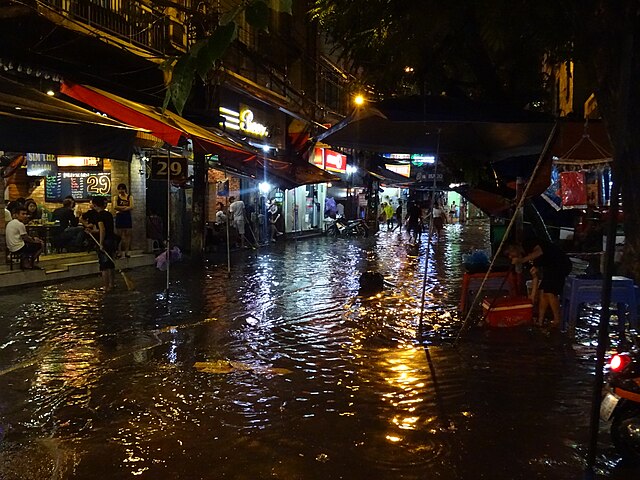
Thammasat University students interested in ASEAN studies, Vietnam, ecology, environmental studies, political science, economics, sociology, and related subjects may find it useful to participate in a free 5 September Zoom webinar on Vietnam’s Energy Transition: Opportunities and Challenges.
The event, on Tuesday, 5 September 2023 at 2pm Bangkok time, is presented by the ISEAS – Yusof Ishak Institute, Singapore.
The TU Library collection includes several books about different aspects of energy usage in Vietnam.
Students are invited to register at this link:
https://us06web.zoom.us/webinar/register/WN_mLIJsOquQ5KhBd8IhIx_yA#/registration
The event webpage explains:
About the Webinar
The National Power Development Plan 8 (PDP8) and National Energy Master Plan (NEMP) for 2021-2030, with a vision to 2050, were released by the Vietnamese government in May and July, respectively. These ambitious plans set out a roadmap for the country’s energy infrastructure development and aim to mobilise international support for Vietnam to achieve the net-zero-emission goal by 2050. The plans have therefore sparked significant public interest, particularly among energy investors, international businesses operating in Vietnam, as well as the country’s development partners. This webinar aims to provide initial insights into these plans, the potential opportunities and challenges that they bring for all stakeholders, as well as their implications for the country’s energy security and energy transition.
About the Speakers
Nguyen Dinh is a Principal at OWC – a company of the ABL Group, a leading independent global energy and marine consultancy with offices in over 40 countries. […]
Phat Nguyen is a Legal Manager of Asian Clean Capital Vietnam. […]

An article posted on the website of the World Bank explains:
Vietnam is increasingly seeing its development affected by climate change and now faces critical questions about how to respond. The Vietnam Country Climate and Development Report proposes that Vietnam shift its development paradigm by incorporating two critical pathways – resilient pathway and decarbonizing pathway – that will help the country balance its development goals with increasing climate risks.
After more than two decades of steady growth, Vietnam has set an ambitious goal of reaching high-income status by 2045. It has been recognized in the 2021-2030 Socioeconomic Development Strategy that the country’s economic transformation will greatly depend on better management of natural capital – the extensive stocks of agricultural, forest, and mineral resources that have helped drive development.
Yet Vietnam, with over 3,200 km of coastline and many low-lying cities and river delta regions, is one of the most vulnerable countries in the world to climate change. Climate change impacts – mainly higher and more variable temperatures and sea level rise – are already disrupting economic activity and undermining growth. Initial calculations suggest that Vietnam lost $10 billion in 2020, or 3.2 percent of GDP, to climate change impacts.
Without proper adaptation and mitigation measures, it is estimated climate change will cost Vietnam about 12 percent to 14.5 percent of GDP a year by 2050 and could plunge up to one million people into extreme poverty by 2030. As Vietnam considers its climate strategy going forward, the CCDR identifies actions and options for both the public and private sector to build climate resilience, achieve the country’s pledge of net-zero greenhouse gas emissions by 2050, and advance socioeconomic development, all while ensuring a “just transition” to support households disrupted by the shift to a climate-resilient, low-carbon economy.
Pursuing a climate-resilient and net zero emissions development pathway is estimated to require additional investments of about 6.8 percent of GDP, or a cumulative US$368 billion through 2040. With the right mix of policies and strategies, Vietnam can leverage its decarbonization efforts to advance development objectives so that achieving net zero emissions does not reduce GDP growth. Government commitments can and should be bolstered by the engagement of the domestic private sector and through external finance, public and private.
KEY RECOMMENDATIONS:
Vietnam CCDR Report
The resilience pathway
Protecting the country’s assets, infrastructure, and people
Adaptation measures should focus on the country’s most vulnerable sectors and locations, particularly agriculture, transport, trade and industry, coastal areas, and the Mekong Delta.
Complementary policy reforms in the fiscal and financial sectors will be needed to stimulate the necessary investments from both the public and private sectors.
Total financing needs are estimated at around $254 billion from 2022 to 2040, including $219 billion for upgrading private assets and public infrastructure, plus $35 billion for social programs.
The decarbonizing pathway
- Bringing Vietnam to net-zero carbon emissions by 2050
- Substantial investments are required in energy, transport, agriculture, and industry.
- Sectoral investments should be supported by carbon pricing instruments, which should change behavior and help finance the transition. For example, an increase in the carbon tax to $29 per ton of carbon dioxide equivalent by 2030 and $90 by 2040 would generate $80 billion in additional revenue.
- Supporting measures will enable the pursuit of the net-zero objective without slowing GDP growth.
- Total financing needs for decarbonization are estimated at $114 billion over 2022-2040: to support the energy transition (about $64 billion); for industry, transport, and agriculture ($17 billion); and for supportive social programs ($33 billion).
Financing the transition
- Mobilizing domestic finance, seeking external support
- Closing the funding gap will require a reallocation of domestic private savings toward climate-related projects, an increase in public savings, and external financial support.
- Public funding could account for about one-third of funding and could be financed through the carbon tax or by borrowing in domestic markets.
- Private financing in the range of 3.4 percent of GDP per year can be mobilized through green credit by banks, green equities and green bonds and applying de-risking tools.
Vietnam CCDR Report
PRIORITIES:
Five priority policy packages require the most immediate attention by government and represent the most urgent public and private investments needed to achieve adaptation and mitigation goals.
- A coordinated regional program for the Mekong Delta.
- An integrated coastal resilience investment program for main urban centers and connecting infrastructure.
- A targeted air pollution reduction program in the Hanoi airshed to reach the WHO interim target by 2030 and enhance labor productivity gains.
- Acceleration of the clean energy transition.
- A new social contract to protect the most vulnerable people.
In July, the Asia Society website added:
Although Vietnam has formally promulgated a net zero target into policy, which is a significant step forward, its updated 2030 target in its latest NDC submitted in 2022 remains insufficient for meeting either Paris Agreement goal to limit global temperature increases to well below 2 degrees and pursue efforts limit increases to 1.5 degrees Celsius. According to Climate Action Tracker, when taking into account its fair share, Vietnam would still need to reduce emissions to 350 MtCO2e by 2030, a level of emissions nearly 2.5 times lower than the 902 MtCO2e that would be achieved based on Vietnam’s unconditional target. More ambitious near- and mid-term targets may thus be needed to maintain Paris alignment and stay on track to reach net zero by 2050. […]
(All images courtesy of Wikimedia Commons)

